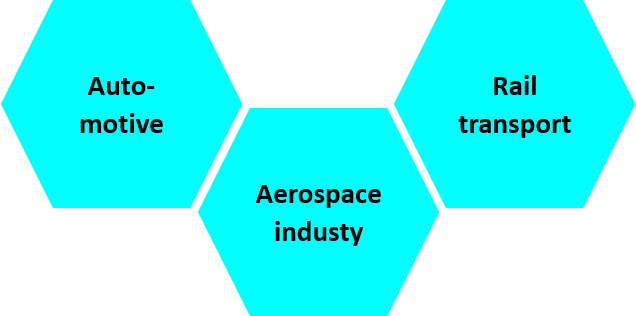The aim of the Technologically Advanced and Safe Transport domain is to increase the reliability and safety of automotive, air and rail transport and road traffic.
The domain is included under the thematic area Transport for the 21st Century.

Why is technologically advanced and safe transport included among the RIS3 priorities?
- Transport is facing fundamental changes due to changing population behaviour. Demands on transport capacity and use are increasing, and thanks to innovation, they will be met more efficiently
- Global trends are leading to the autonomous use of different means of transport, increasing the requirements to ensure their safety and remove barriers to the acceptance of new modes of transport.
- Technology is penetrating all areas of transport, especially in terms of artificial intelligence, signal processing and automated processing, and other.
Application sectors in the thematic area
The Transport for the 21st Century thematic area includes three application sectors:
- Automotive deals with the development, manufacture, marketing, sale, maintenance and disposal of on-road and off-road motor vehicles and their accessories. For the purposes of the RIS3 strategy, this sector includes on-road and off-road passenger and freight vehicles, buses, electric buses and trolleybuses.
- The aerospace industry focuses on research and innovation of aircraft components such as aircraft engines (turbines), leading edges, compressors, wheels, brakes, etc., as well as aircraft structure (design) and construction. Another important area of R&D is the technologies and materials used in aircraft manufacturing (e.g. precision casting, composite materials, surfaces and their processing, etc.).
- Rail Transport is involved in research and innovation of locomotives and rail vehicles (including trams) and their components (seats, engines, axles, chassis, doors, etc.)
Strategic themes for research and innovation in application sectors
Autonomous mobility
The strategic theme “Autonomous mobility” covers a wide range of technical, systemic and socio-economic aspects related to the further development of the autonomous mobility trend. The related R&D&I activities and innovation support in this strategic theme will help accelerate the transition from the development to the implementation phase and will allow to strengthen the competitiveness of the Czech Republic in this area, which will be crucial in the further development of transport. The benefits associated with the gradual introduction of vehicles with advanced assistance systems into operation are mainly related to increased traffic safety, improved transport serviceability and accessibility of transport, and user- and environment-oriented services and concepts. The strategic theme also includes development in the field of rail transport using autonomous systems, possibly in other modes of transport (waterway transport). Progress can be made in this area and expert capacity building can also be strengthened through cooperation between research institutions and the private sector, producing results that contribute to the development of system solutions and the commercialisation of technological outputs
Unmanned systems (drones) and U-Space
The field of unmanned systems (drones) and related services is a dynamically developing sector, which brings a number of potential benefits and challenges, but also societal risks. Applications can be seen in both the private and public sectors. The development of technologies, procedures and infrastructure and the creation of an optimal environment for the advanced and efficient operation of drones in the Czech Republic, including U-Space services, will enable the full potential to be exploited while gaining the tools to control risks. At the same time, it will enable the Czech Republic and its entities to be competitive in the European and global context. This can have significant societal and economic benefits
Technology for satellites and vertical constellations
The field of space technology and applications has been undergoing dramatic development in the last few years. The rapidly increasing demand for satellite data and services has accelerated the emergence of private investment in space activities, giving the entire sector a whole new dynamic. There are undoubtedly multiple factors, including the declining costs of satellite launches, rapidly increasing performance and overall developments in ICT, miniaturisation, and technology evolution. In addition to the rapid growth in interest from private users, there has also been a steady increase in interest from government institutions in areas such as satellite telecommunications, satellite navigation and Earth observation. As the number of small satellites in orbit is increasing, there is also a trend towards non-orbital high atmosphere platforms (HAPS) that can serve an area the size of a smaller region. Both small satellites and HAPS are promising technologies with a high commercialisation potential, which, in combination (vertical constellation), can provide even more interesting and desirable solutions.

Key enabling technologies in the Technologically Advanced and Safe Transport domain
In this domain, the following key enabling technologies are particularly applicable. Each of them can be used to innovate in all application sectors belonging to this domain, but also in other areas.
- Photonics and micro-/nano-electronics
- Advanced materials and nanotechnology
- Artificial Intelligence
- Digital security and connectivity
The specific research and innovation themes for key enabling technologies in this domain can be found in Annex 1 to the National RIS3.
More detailed general information on key enabling technologies can be found here.
Themes concerning social sciences, humanities and arts included under the Technologically Advanced and Safe Transport domain
The following SSHA themes will be explored and developed in this domain:
- Research on the interrelationships between society, technology and innovation
- Conditions/barriers to the application of innovative technologies and practices
- Security Research
More detailed general information on the themes of social sciences, humanities and arts can be found here.
National Innovation Platform Transport for the 21st Century
National Innovation Platforms are working groups where the entrepreneurial discovery process (EDP) is put into practice.
The domain of Technologically Advanced and Safe Transport is the subject of discussions in the National Innovation Platform III - Transport for the 21st Century, where representatives of business, research and the public sphere meet; this is the well-known Triple Helix model.
Contacts:
![]() Professional guarantor of National Innovation Platform III - Transport for the 21st Century: Zdeněk Lokaj, Faculty of Transport Czech Technical University in Prague, lokaj@fd.cvut.cz
Professional guarantor of National Innovation Platform III - Transport for the 21st Century: Zdeněk Lokaj, Faculty of Transport Czech Technical University in Prague, lokaj@fd.cvut.cz
![]() Professional guarantor of the National Innovation Platform III - Transport for the 21st Century: Ondřej Mirovský, Technology centre CAS, mirovsky@tc.cz
Professional guarantor of the National Innovation Platform III - Transport for the 21st Century: Ondřej Mirovský, Technology centre CAS, mirovsky@tc.cz
![]() Secretary of National Innovation Platform III - Transport for the 21st Century: Jan Bilík, MIT CR, bilik@mpo.cz
Secretary of National Innovation Platform III - Transport for the 21st Century: Jan Bilík, MIT CR, bilik@mpo.cz

